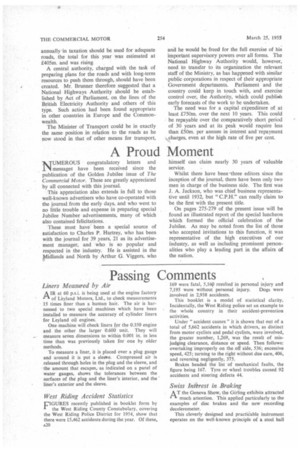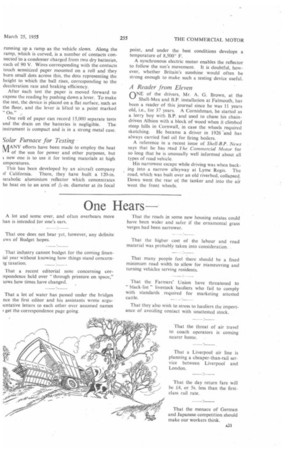Passing Comments
Page 22

Page 23

If you've noticed an error in this article please click here to report it so we can fix it.
Liners Measured by Air
AIR at 60 p.s.i. is being used at the engine factory of Leyland Motors, Ltd., to check measurements 15 times finer than a human hair. The air is harnessed to two special machines which have been installed to measure the accuracy of cylinder liners for Leyland oil engines.
One machine will check liners for the 0.350 engine and the other the larger 0.600 unit. They will measure seven dimensions to within 0.001 in. in less time than was previously taken for one by older methods.
To measure a liner, it is placed over a plug gauge and around it is put a sleewe. Compressed air is released through holes in the plug and the sleeve, and the amount that escapes, as indicated on a panel of water gauges, shows the tolerances between the surfaces of the plug and the liner's interior, and the liner's exterior and the sleeve.
West Riding Accident Statistics
FIGURES recently published in booklet form by the West Riding County Constabulary. covering the West Riding Police District for 1954, show that there were 15,462 accidents during the year. Of these, A20
169 were fatal, 5,16B resulted in personal injury and 7,195 were without personal injury. Dogs were involved in 2,938 accidents.
This booklet is a model of statistical clarity. Incidentally, the West Riding police set an example to the whole country in their accident-prevention activities.
Under "accident causes" it is shown that out of a total of 5,662 accidents in which drivers, as distinct from motor cyclists and pedal cyclists, were involved, the greater number, 1,269, was the result of misjudging clearance, distance or speed. Then follows: overtaking improperly on the off side, 536; excessive speed, 425; turning to the right without due care, 406, and reversing negligently, 375.
Brakes headed the list of mechanical faults, the figure being 167. Tyre or wheel troubles caused 92 accidents and steering defects 44.
Swiss Interest in Braking
AT the Geneva Show, the Girl ing exhibits attracted " much attention. This applied particularly to the examples of disc brakes and the new recording decelerometer.
This cleverly designed and practie'able instrument operates on the well-known principle of a steel ball
running up a ramp as the vehicle slows. Along the ramp, which is curved, is a number of contacts connected to a condenser charged from two dry batteries, each of 90 V. Wires corresponding with the contacts touch sensitized paper mounted on a roll and they burn small dots across this, the dots representing the height to which the ball rises, corresponding to the deceleration rate and braking efficiency.
After each test the paper is moved forward to expose the reading by pushing down a lever. To make the test, the device is placed on a flat surface, such as the floor, and the lever is lifted to a point marked " On."
One roll of paper can record 15,000 separate tests and the drain on the batteries is negligible. The instrument is compact and is in a strong metal case.
Solar Furnace for Testing
!MANY efforts have been made to employ the heat Lvl of the sun for power and other purposes, but t new one is to use it for testing materials at high emperatures.
This has been developed by an aircraft company )f California. There, they have built a 120-in. iarabolic aluminium reflector which concentrates he heat on to an area of diameter at its focal point, and under the best conditions develops a temperature of 8,500° F.
A synchronous electric motor enables the reflector to follow the sun's movement. It is doubtful, however, whether Britain's sunshine would often be strong enough to make such a testing device useful.
A Reader from Eleven
nNE of the drivers, Mr. A. G. Brown, at the Shell-Mex and B.P. installation at Falmouth, has been a reader of this journal since he was 11 years old, i.e., for 37 years. A Cornishman, he started as a lorry boy with B.P. and used to chase his chaindriven Albion with a block of wood when it climbed steep hills in Cornwall, in case the wheels required skotching. He became a driver in 1926 and has always carried fuel oil for firing boilers.
A reference in a recent issue of She News says that he has read The Commercial Motor for so long that he is unusually well informed about all types of road vehicle.
His narrowest escape while driving was when backing into a narrow alleyway at Lyme Regis. The road, which was built over an old riverbed, collapsed. Down went the rear of the tanker and into the air went the front wheels.
























































































